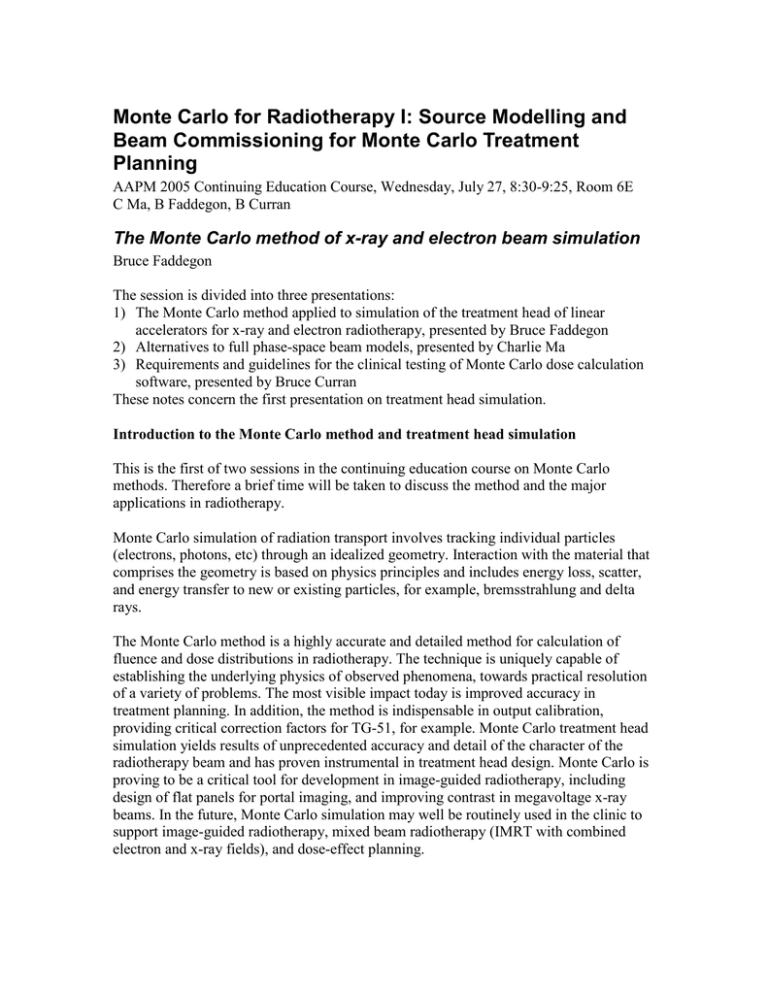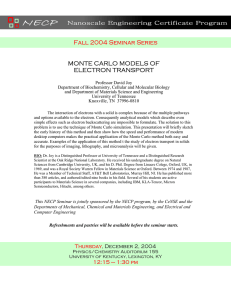Monte Carlo for Radiotherapy I: Source Modelling and Planning
advertisement

Monte Carlo for Radiotherapy I: Source Modelling and Beam Commissioning for Monte Carlo Treatment Planning AAPM 2005 Continuing Education Course, Wednesday, July 27, 8:30-9:25, Room 6E C Ma, B Faddegon, B Curran The Monte Carlo method of x-ray and electron beam simulation Bruce Faddegon The session is divided into three presentations: 1) The Monte Carlo method applied to simulation of the treatment head of linear accelerators for x-ray and electron radiotherapy, presented by Bruce Faddegon 2) Alternatives to full phase-space beam models, presented by Charlie Ma 3) Requirements and guidelines for the clinical testing of Monte Carlo dose calculation software, presented by Bruce Curran These notes concern the first presentation on treatment head simulation. Introduction to the Monte Carlo method and treatment head simulation This is the first of two sessions in the continuing education course on Monte Carlo methods. Therefore a brief time will be taken to discuss the method and the major applications in radiotherapy. Monte Carlo simulation of radiation transport involves tracking individual particles (electrons, photons, etc) through an idealized geometry. Interaction with the material that comprises the geometry is based on physics principles and includes energy loss, scatter, and energy transfer to new or existing particles, for example, bremsstrahlung and delta rays. The Monte Carlo method is a highly accurate and detailed method for calculation of fluence and dose distributions in radiotherapy. The technique is uniquely capable of establishing the underlying physics of observed phenomena, towards practical resolution of a variety of problems. The most visible impact today is improved accuracy in treatment planning. In addition, the method is indispensable in output calibration, providing critical correction factors for TG-51, for example. Monte Carlo treatment head simulation yields results of unprecedented accuracy and detail of the character of the radiotherapy beam and has proven instrumental in treatment head design. Monte Carlo is proving to be a critical tool for development in image-guided radiotherapy, including design of flat panels for portal imaging, and improving contrast in megavoltage x-ray beams. In the future, Monte Carlo simulation may well be routinely used in the clinic to support image-guided radiotherapy, mixed beam radiotherapy (IMRT with combined electron and x-ray fields), and dose-effect planning. This session focuses on simulation of the head of linear electron accelerators used in radiotherapy down through the patient. Accurate source modeling is a pre-requisite to accurate treatment planning with Monte Carlo methods. Since the planning system is physically based, the model of the clinical electron and x-ray sources used in the dose calculation must be detailed and accurate as well. Many people have contributed to this field. Course attendees are referred to the extensive literature on the subject. Starting points for treatment head simulation include: 1) D. W. O. Rogers, B.A. Faddegon, G. X. Ding, C.-M. Ma, J. We, and T. R. Mackie, BEAM: A Monte Carlo code to simulate radiotherapy treatment units. Med. Phys. 22(5):503, 1995 2) C.L. Hartmann-Siantar, R.S. Walling, T.P. Daly, B. Faddegon, N. Albright, P. Bergstrom, A.F. Bielajew, C. Chuang, D. Garrett, R.K.House, D. Knapp, D.J. Wieczorek and L.J. Verhey, Description and dosimetric verification of the PEREGRINE Monte Carlo dose calculation system for photon beams incident on a water phantom. Med. Phys. 28(7):1322-1337, 2001 3) D. Sheikh-Bagheri, D.W.O. Rogers, Sensitivity of megavoltage photon beam Monte Carlo simulations to electron beam and other parameters. Med. Phys. 29(3):379, 2002 4) B.A. Faddegon, E. Schreiber, X. Ding, Monte Carlo simulation of large electron fields, Phys. Med. Biol. 50: 741-753, 2005 Treatment head simulation method and software This presentation provides an overview of what can be done and how to go about doing it. Given the energy of an x-ray beam, the angular distribution of intensity can be calculated by Monte Carlo with an accuracy of 3% over the clinical range of field sizes (see B.A. Faddegon, C. K. Ross, and D. W. O. Rogers, Angular Distributions of Bremsstrahlung from 15 MeV Electrons Incident on Thick Targets of Be, Al and Pb, Med Phys 18(4):727, 1991). A match to measured output and dose distributions is possible, with careful measurement and attention to detail, of (2±1)%/ (2±1)mm for the full range of beams, field sizes, SSD used in conventional radiotherapy (see papers cited earlier, for example). Instruction in treatment head simulation will be by the following example: Large field electron simulation. The procedure is divided into the following steps. 1) Acquire the Monte Carlo system and learn what it does and how to use it. 2) Draw up an idealized schematic of the treatment head based on manufacturer specifications. Obtain information on tolerance along with specification of materials and geometry. It may help to request this information as part of equipment purchase. 3) Start with realistic parameters. Adjust these, based on the results, keeping the parameters within reasonable ranges, to come up with source and geometry parameters that give a reasonable fit to measurement, say, 3-5%/3-5 mm. 4) Do a sensitivity analysis, adjusting the nominal parameters over an acceptable range, or find a sensitivity analysis in the literature for your particular machine. Results of xray and electron sensitivity analysis for specific machines will be briefly reviewed. 5) Refine the source and geometry parameters using results of the sensitivity analysis and knowledge of the accuracy of the measurements and stability of the machine. Resolve discrepancies using the power of the Monte Carlo method and further measurements. 6) To improve accuracy in source and geometry deduction, use the full range of beam energies, field sizes, beam modifiers, SSD, etc at your disposal.





